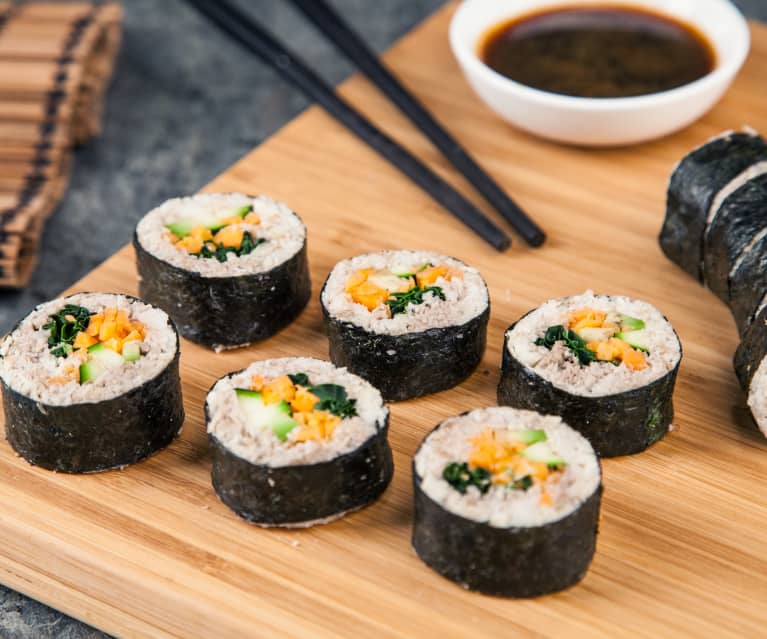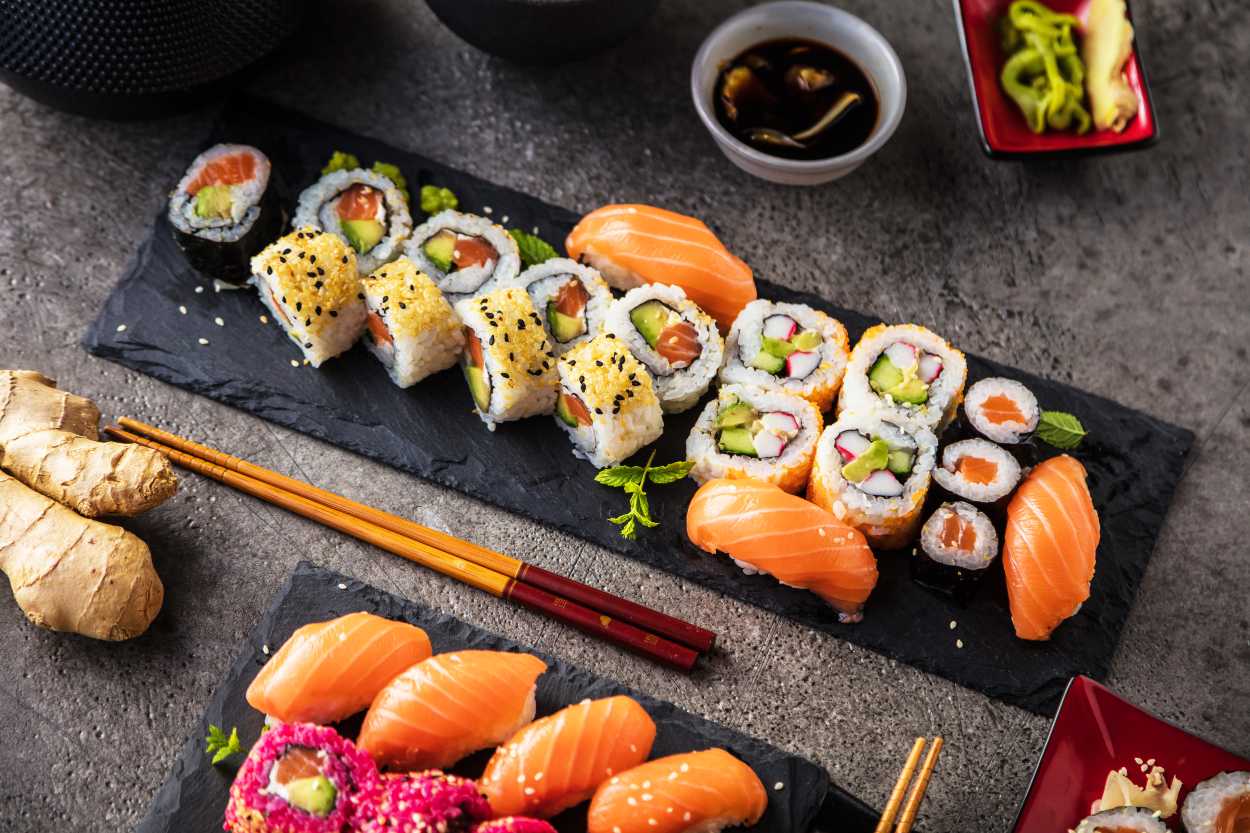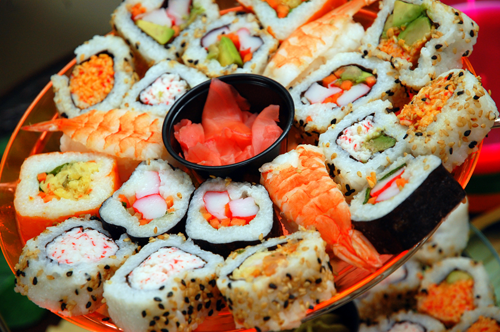Sushi's History and recipe for it

Sushi has a rich history that spans over a thousand years and has evolved from a preservation method to an internationally popular culinary delight. Here's a brief history of sushi:
1. Origins in Southeast Asia:
- The concept of preserving fish in fermented rice originated in Southeast Asia, possibly along the Mekong River. This method was developed as a way to ferment and preserve fish in rice, creating a form of pickled fish.

2. Arrival in Japan:
- Sushi made its way to Japan around the 8th century, where the Japanese people adopted and modified the preservation techniques. During the Edo period (1603-1868), a chef named Hanaya Yohei is often credited with transforming sushi into the bite-sized, hand-rolled form that we are more familiar with today.

3. Nigiri and Edomae-zushi:
- In the early 19th century, Hanaya Yohei opened one of the first sushi stalls in the Ryogoku district of Edo (now Tokyo). He started serving bite-sized portions of rice topped with fresh fish, a style known as nigiri sushi. This marked the beginning of what is now called Edomae-zushi, a style of sushi made with fresh fish from the Tokyo Bay.
4. Introduction of Nori:
- The use of nori (seaweed) as a wrapping for sushi became popular in the 18th century. It provided a convenient way to hold the rice and fish together, especially for hand-rolled sushi.

5. Modern Sushi:
- Sushi gained widespread popularity in Japan during the 20th century. After World War II, sushi evolved further with the introduction of refrigeration, allowing for the use of raw fish without the need for fermentation. Conveyor belt sushi (kaiten-zushi) also emerged, making sushi more accessible to the general public.

6. Global Spread:
- Sushi's popularity expanded beyond Japan in the mid-20th century. Sushi bars and restaurants began to appear in major cities worldwide, with the United States being a significant adopter of sushi culture. Sushi underwent further transformations to cater to diverse tastes, with the invention of rolls like the California roll, which includes avocado and crab.

Today, sushi is enjoyed worldwide, and its preparation and presentation continue to evolve. It remains a symbol of Japanese culinary artistry and has become an integral part of global gastronomy.
Preparing sushi at home;
Making sushi at home can be a fun and rewarding experience. Here's a basic recipe for making traditional sushi rolls, known as maki rolls. This recipe will guide you through making a classic California roll:
Ingredients:
For Sushi Rice:
- 2 cups sushi rice
- 2 1/2 cups water
- 1/2 cup rice vinegar
- 1/4 cup sugar
- 1 teaspoon salt
For California Roll:
- Nori (seaweed) sheets
- 1 cup crab meat (imitation crab or real crab, shredded)
- 1 avocado, sliced
- Cucumber, julienned
- Soy sauce for dipping
- Pickled ginger for serving
- Wasabi for serving
Instructions:
1. Prepare Sushi Rice:
- Rinse the sushi rice under cold water until the water runs clear.
- In a rice cooker or on the stovetop, cook the rice according to the package instructions.
- While the rice is still hot, mix rice vinegar, sugar, and salt in a bowl until the sugar and salt dissolve. Gently fold the vinegar mixture into the hot rice and let it cool to room temperature.
2. Prepare Filling:
- If using real crab, shred the crab meat. If using imitation crab, you can use it as is.
- Slice the avocado and julienne the cucumber.
3. Assemble the Sushi:
- Place a bamboo sushi rolling mat on a clean surface.
- Lay a sheet of nori, shiny side down, on the bamboo mat.
- Wet your hands to prevent the rice from sticking. Take a handful of sushi rice and spread it evenly over the nori, leaving a small border at the top.
- Arrange a line of crab, avocado, and cucumber along the bottom edge of the nori.
4. Roll the Sushi:
- Lift the edge of the bamboo mat closest to you, and tightly roll the nori over the filling.
- Seal the edge with a bit of water.
- Using a sharp knife, wet it to prevent sticking and slice the roll into bite-sized pieces.
5. Serve:
- Arrange the sushi rolls on a plate.
- Serve with soy sauce, pickled ginger, and wasabi.
Feel free to get creative with your sushi fillings and try different combinations to suit your taste. Enjoy your homemade California rolls!
Here are some links that I can recommend you to watch how to do sushi videos on youtube;
1) https://youtu.be/nIoOv6lWYnk?si=CIriYZcT85k2EBij
2) https://youtu.be/EGeNKGosXA8?si=Pwv6w_i8Z4YBh9SI
3) https://youtu.be/AI4RsauV3sI?si=GDbKdhIqdBi6P2a7
4) https://youtu.be/joweUxpHaqc?si=5pw9FjSfRBYTSnp0
References;
- "Sushi – How-To". FineCooking. May 1, 1998. Archived from the original on November 4, 2019. Retrieved November 4, 2019.
- ^ "The Mysteries of Sushi – Part 2: Fast Food". Toyo Keizai. May 23, 2015. Archived from the original on September 9, 2017.
- ^ "When Sushi Became a New Fast Food in Edo". Nippon.com. December 22, 2020. Archived from the original on January 18, 2021.
- ^ "Sushi". Nihonbashi. Archived from the original on December 28, 2021.
- ^ "Sashimi vs Sushi – Difference and Comparison | Diffen". www.diffen.com. Archived from the original on June 5, 2019. Retrieved June 5, 2019.
- a b Lee, Cherl-Ho; Steinkraus, Keith H; Reilly, P.J. Alan (1993). Fish fermentation technology. Tokyo: United Nation University Press. OCLC 395550059. Archived from the original on January 13, 2021. Retrieved June 17, 2021.
- a b c d e Hirofumi Akano. "The evolution of sushi and the power of vinegar". Japan Science and Technology Agency. p. 201, 202. Archived from the original on February 14, 2023. Retrieved April 4, 2023.









































![[LIVE] Engage2Earn: Shayne is helping koalas!](https://cdn.bulbapp.io/frontend/images/08e2e573-f490-4ef4-93b6-f2285814da59/1)










